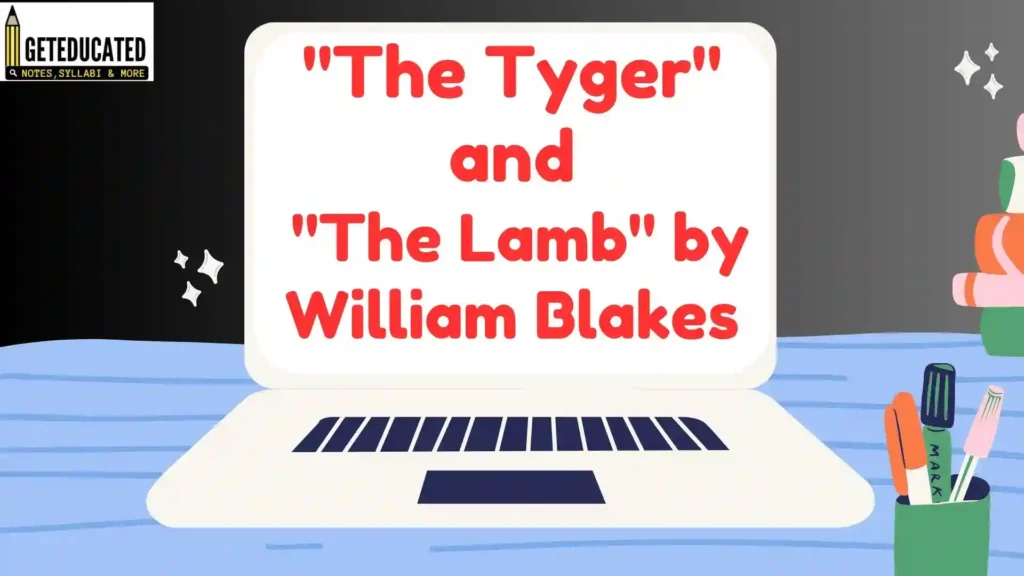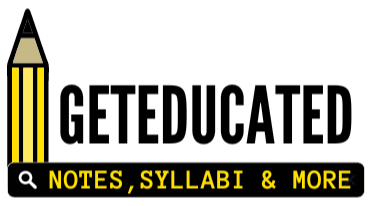
Q. Explain the Use of Symbolism in The Tyger and The Lamb.
Symbol is a mode of expression in which a writer depicts indirectly through the medium of another object. But symbol is not a mere substitution of one object for another. There is much more to it. Symbolism is the art of evoking an object little by little to reveal a mood or emotion or some mysterious region of human psyche The poetry as well as the whole art of William Blake is abundant with symbols. There is hardly any poem in the “Songs of Innocence and Experience” which does not possess symbols. Blake’s famous symbols are children, flowers and seasons to symbolize innocence. Although regarded by some as a collection of poems for children, the Songs can actually be read as an exploration of human spiritual growth as well as a representation of what Blake himself called “the two contrary states of the human soul”. The antithesis of innocence and experience is visible in the richness of symbols present in this ensemble of poems. Religious figures, animals, tales of light and darkness oppose each other. The positive outlook of Innocence emerges in contrast to the gloomy world of the experienced adult in Experience. One of Blake’s most famous dual symbols and the one most closely linked with his reflections on the French Revolution is the Lamb/Tiger. … (Read More)
Q. Distinguish between William Blake’s “The Lamb” and “The Tyger”.
In William Blake’s Songs of Innocence and Songs of Experience, he creates a series of poems that contrast one another such as “The Lamb” which describes an innocent, child-like view of the world and “The Tyger” which describes a more mature world-view. In Blake’s poem “The Lamb,” he has an innocent child speaking to a lamb about God and the wondrous gift of life that the lamb has received and how the Son of God is also called a Lamb (Blake 120 Line 14). Blake uses this innocent and joyous conversation to portray the infinite goodness of God as seen through the worshipful eyes of a child. In contrast, Blake’s poem entitled “The Tyger” is questioning why the God who made the gentle lamb would also make such a ferocious creature as the Tyger (Blake 130 Line 20). Instead of the stated assurance of the child in “The Lamb,” “The Tyger” is a constant questioning with no hints of the innocence in the previous poem. The speaker of “The Tyger” is more mature in the words picked to describe the Tyger while the word choice in “The Lamb” is more artless. The differences in William Blake’s “The Lamb” and “The Tyger” are shown by the innocent child speaker in “The Lamb” and the more mature speaker in “The Tyger” in which contrasting techniques are used to juxtapose the two poems: the simpler sentence structure used in “The Lamb” and the more complicated rhetorical questions used in “The Tyger”; the ingenuous word choices in “The Lamb” and the more sophisticated ones in “The Tyger”; and the literal assurance of the child in “The Lamb” that God is the Creator and the lack of an answer for a creator in “The Tyger.” “The Lamb” is indeed a Song of Innocence while “The Tyger” is a Song of Experience. … (Read More)
Q. Describe Animal Imagery in Blake’s Poems.
Animal imagery in literature is more often than not used to depict human beings via animal traits or by suggesting some resemblance between the human characters and the image of the animal used for them. It is done to suggest the actual nature of human beings using the habits and conduct as well as the instincts of animals. Animal imagery has not only been used by poets but the authors of plays and novels alike have utilized this tool to vividly describe and portray various characters in their works. It’s a way of symbolizing animal characters by passing on their characteristic features to human characters. It may also be suggestive of the animal peculiarities that one should be watchful of, in human beings. … (Read More)
Q. What is Blake’s Message about Society in his Poems?
As one of the most outstanding representatives of the Pre-Romanticism poet in the 18th century English literature, William Blake lived through and witnessed an era of great political and social upheaval and transitional period: the American War of Independence, the French Revolution, and the Industrial Revolution which brought significant and essential impact on social and historical progress in England. Coming from the social injustices and the coverage of the dark side of industrial England, Blake caught the pulse of his times through his sharp and deep insight, condemned the oppression and exploitation derived from the authority, tyranny and church, and also called on the oppressed to shatter “the mind-forged manacles” come from the ruling class. … (Read More)

[…] The Lamb and The Tyger Long Questions and Answers […]
[…] The Lamb and The Tyger Long Questions and Answers […]